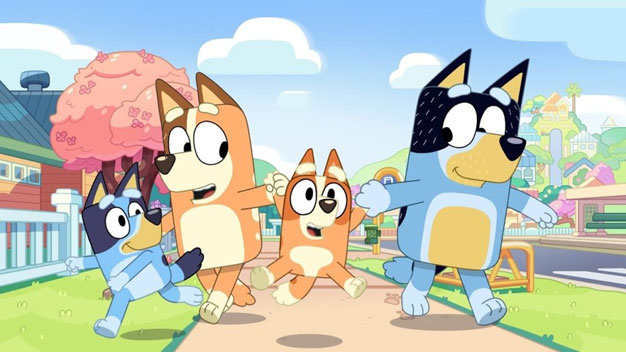
Season 3 of “Bluey” is streaming now on Disney+.
By Lindsay Steele
The Catholic Messenger
“Bluey” (Ludo Studio/ Australian Broadcasting Corporation)
Genre: Cartoon/children’s show
Audience: Family and kids
Streaming service: Disney+
Rating: TV-Y (some cartoon mischief)
Summary: Bluey follows the adventures of a lovable and inexhaustible anthropomorphic 6-year-old Blue Heeler puppy who lives with her dad, mom and 4-year-old little sister, Bingo.
Synopsis: Bluey, the number one television program on Disney+ in the U.S. even before the much-anticipated release of its third season Aug. 10, is a children’s show that also seems to appeal to adults. I believe this is due to its portrayal of parents as imperfect; we see their struggles alongside the children’s struggles.
On shows like Daniel Tiger’s Neighborhood (PBS), parents don’t get angry and they never seem to say the wrong thing. The adults in these shows teach children how to behave and relate to the world, leading by example. There are lessons to be learned in Bluey, as well, such as the importance of keeping promises and of playing fair, but there’s a lot more chaos and messiness involved.
Chilli and Bandit Heeler are loving parents but Bandit struggles with immaturity and Chilli has unrealistic expectations for herself as a working mother, often comparing herself to other moms who seem to do things better. We see Chilli and Bandit groan in annoyance when their children wake up at night, even though they want to tend lovingly to Bluey and Bingo’s needs. The kids often serve as motivation for the parents to strive to become better versions of themselves. This messiness may not be ideal, but it’s relatable.
Supporting characters also have challenges; babysitter Frisky is afraid to date again after having her heart broken and Bandit’s younger adult brother expresses frustration with always feeling second best. I most relate to the episode where Bandit enjoys interacting with another dad at the park but isn’t sure how to turn that acquaintanceship into an actual friendship.
As refreshing and validating as it may be for parents to see themselves on screen, it’s a double-edged sword when it comes to children viewing that portrayal. They may wonder why the Heeler kids seem to be rewarded for bad behavior at times. Bandit, in particular, seems to have a difficult time saying “no” to the kids. It’s good for kids to know that all parents make mistakes sometimes but parents may need to put this into context so their children don’t see this type of parental behavior as ideal. Additionally, children may wonder why their own parents don’t do silly dances in public or dress like babies during games of “house.” Adults may need to remind their children that the Heelers are a cartoon family of dogs and that some of their sillier antics might not be appropriate in the real world.
Discussion questions:
Do you think it is better for a children’s program to portray “perfect” parents or flawed parents?
What do you believe should be the objective of children’s programming?
What children’s programs would you recommend to parents and caregivers, and why?
(Editor’s note: Lindsay Steele is a reporter for The Catholic Messenger. Contact her at steele@davenportdiocese.org or by phone at (563) 888-4248.)











